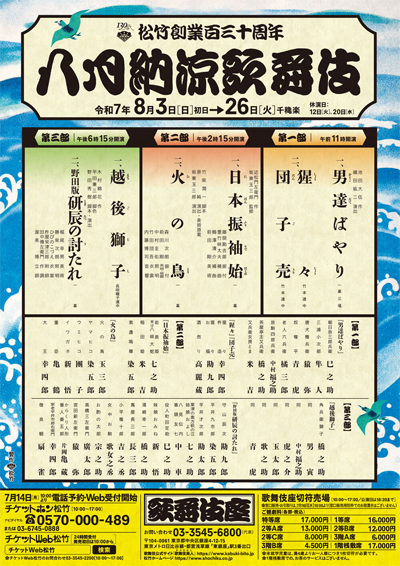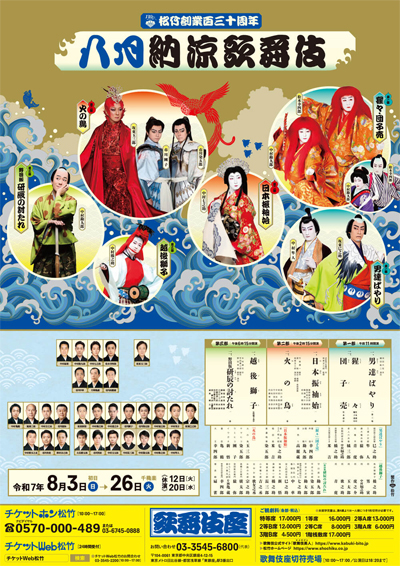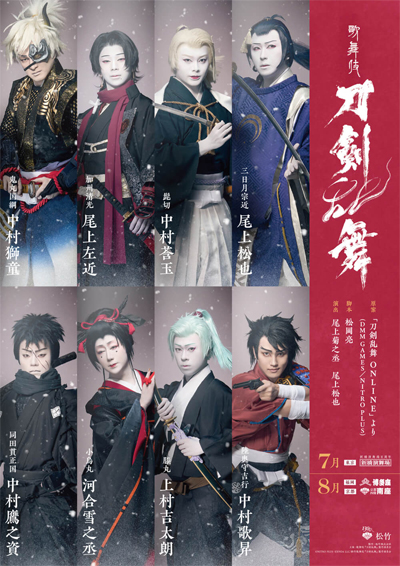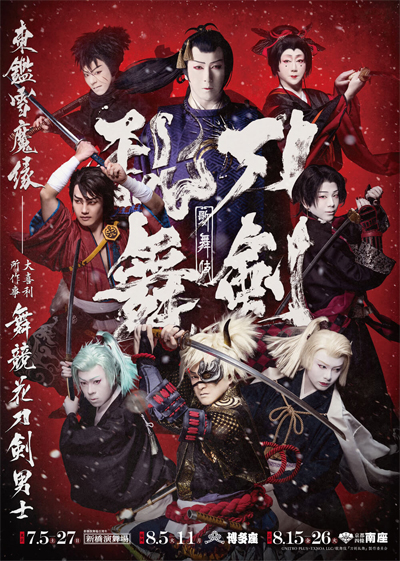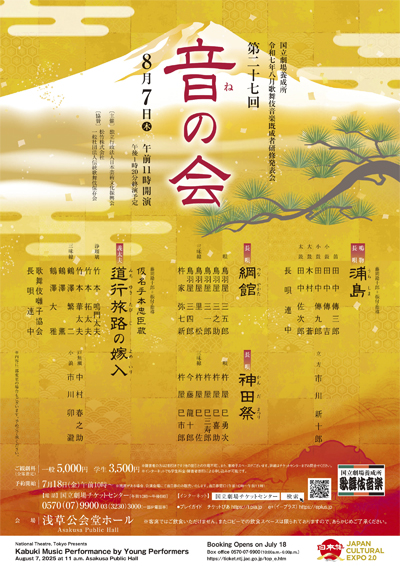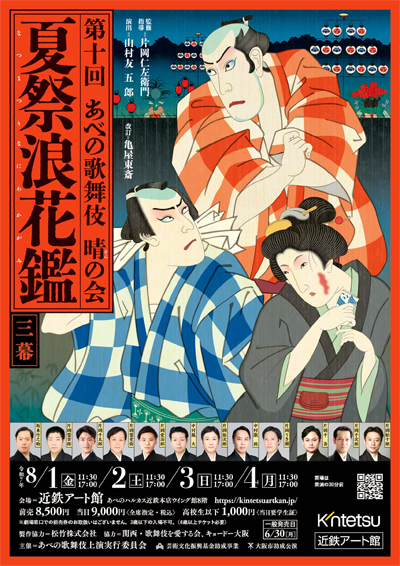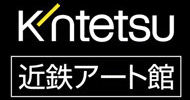| Comments |
The August Young Actors Kabuki performances at the Kabukiza with Living National Treasure Band˘ Tamasabur˘ as the guest star!
Otokodate Bayari:
(Chivalrous Spirit in Fashion)
In the streets of Edo, tensions run high between the hatamoto yakko (samurai retainers)
and the machi yakko (town servants), constantly competing for pride and dominance.
One day, Miura Kojir˘ (Nakamura Hayato), a hatamoto yakko,
is walking along the banks of Shinobazu Pond in Ueno
when he encounters an elderly man attempting to drown himself. Miura tries to save him but, unable to swim, he can only stand there helplessly.
Just then, a boatman rowing a small boat pulls the old man out of the water. The old man, Rokubŕ (ACT), explains that after the death of his daughter,
his son-in-law Matabŕ and Matabŕ's new wife began to despise him, driving him to attempt suicide.
The boatman encourages Rokubŕ to open a teahouse to rival Matabŕ's, promising to prepare thirty ry˘
by the next day to make it possible. Miura, who has witnessed the scene, offers to act as a witness and agrees to meet again
the following morning. The next morning, the man who enters Matabŕ's teahouse is none other than the boatman who saved RokubŕŚAsahina Saburobŕ (Band˘ Minosuke),
a machi yakko from the Banzuiin Ch˘be gang. Miura, the hatamoto yakko, and Asahina, the machi yakko,
exchange their names, and soon, the two begin to clash in a fierce battle of pride with the fiery sparks that fly in this showdown of male pride.
Sh˘j˘: the sh˘j˘ is a
mythical sake-loving spirit that lives in the sea. In this dance, a
sake seller has a mysterious customer
that appears daily and drinks enormous amounts with great satisfaction.
The sake seller has a dream with
instructions to go by the beach with a large tub of sake.
As it turns out, the customer has actually been the sh˘j˘
in disguise. The dance shows two sh˘j˘ as they drink and dance joyfully.
Starring Nakamura Kankur˘ and Matsumoto K˘shir˘ as the sh˘j˘ and
Ichikawa Komaz˘ as the sake seller.
Dango Uri:
(The Dumpling Peddlers)
the mortar and pestle used for pounding rice cakes
and dumplings are a symbol of a happily married couple. This short, lively
dance shows a couple peddling dumplings with a series of songs and dances.
Starring Matsumoto K˘shir˘ and Nakamura Kankur˘ in the roles of the husband and the wife.
Nihon Furisode Hajime: this dance is a rare example of a story from ancient Japanese
mythology in a puppet play by Chikamatsu Monzaemon adapted for the Kabuki theater.
As part of an annual ritual, Princess Inada has been chosen to be sacrificed to a fierce serpent
that lives in the mountains of Izumo. The serpent arrives in the guise of a beautiful princess,
but before it can attack it is attracted to eight jars full of sake.
The jars are a trap planted by the god Susanoo, who confronts the beast in its true form as an
eight-headed serpent, to save the princess. Starring Nakamura Shichinosuke as the serpent,
with Ichikawa Somegor˘ and Nakamura Yonekichi in the roles of Susanoo and Princess Inada.
Hi no Tori: in the land ruled by the Great King (Matsumoto K˘shir˘), endless bloodshed has expanded his territory through repeated invasions
of many nations. Now aged and suffering from illness, the Great King seeks to possess the Phoenix,
a bird of eternal power, in hopes of gaining everlasting life. The two princes, Yamahiko (Ichikawa Somegor˘) and Umihiko (Ichikawa Danko),
are ordered to capture the Phoenix (Living National Treasure Band˘ Tamasabur˘) and embark on a journey to a distant land where the Phoenix has been said to dwell since ancient times.
In a garden where mysterious, shining golden apple trees grow thick, the two brothers encounter a figure who introduces himself as Iwagane (Band˘ Shingo).
Hi no Tori (The Phoenix), a story that has inspired ballet and manga, now comes to life as a brand-new Kabuki production.
Echigo Jishi: one of the most popular dances in the Kabuki repertory, this shows 4 traveling
entertainers (Nakamura Hashinosuke/Nakamura Toranosuke/Nakamura Fukunosuke/Nakamura Utanosuke) that performed lion dances, with an adult playing the music and a child doing acrobatics like
a little lion. The dance shows the feelings of the performers and their feelings for their home in the
Echigo region and finally ends with the famous white cloth of
the area as they wave long strips of cloth in a variety of different patterns.
Sources: Earphone Guide website.
Togitatsu no Utare: a noda-ban revision of the Kabuki drama "Togitatsu no Utare" about Moriyama Tatsuji (Nakamura Kankur˘),
a sword-sharpener from the commoner class who was recently accepted to samurai rank.
His "successful" rise in the hierarchy was merely the result of his clever verbal tactics and materialistic values.
He happens to become caught in a situation in which he is hunted by two brothers, Hirai Saijir˘ (Nakamura Kantar˘) and Hirai Kuichir˘ (Ichikawa Somegor˘),
avenging their father's death.
The avengers are as reluctant as Tatsuji, who is entirely exhausted by continually escaping from them. Isn't the revenge simply a murder?
What is all this killing for? Visual quotations from global culture, such as baseball and West Side Story,
sparklingly decorate the piece on the surface, yet dark questions still lie just underneath.
Featuring also Matsumoto K˘shir˘, Nakamura Senjaku, Kataoka Kamez˘, Ichikawa Chűsha, Band˘ Minosuke, Band˘ Shingo & Nakamura Hashinosuke.
Sources: Earphone Guide Website or Sh˘chiku Kabuki Official Website
|



